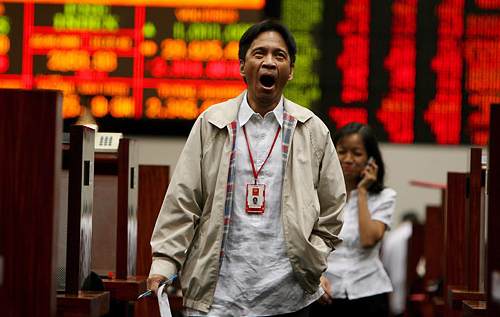Lehman brothers filed for chapter 11 bankruptcy. It was still trading at US$15.00 per share 11 days ago. It is now trading at $0.30. Care to buy Lehman for US$206.7M?
Major holders include some of the biggest mutual funds and financial companies all over the world.
Lehman's major holders include the following companies (figures inside parenthesis are their holdings valuation as of June 2008):
1. AXA Life (US$1.3B)
2. FMR (US$783M)
3. Clearbridge Advisors (US$776M)
4. Barclays (US#539M)
5. Fidelity Diversified (>US$420M)*
6. Vanguard (>US$452M)*
* represents mutual fund exposure
In the Philippines, Metrobank, BDO, RCBC, and Philam Life are some of the companies associated with Lehman. Already, the market crashed 4% yesterday. This day, it inched up 1%.
What is peculiar about this resort to Chapter 11 is that Lehman seemed to be in good shape. In March of this year, Citigroup researchers even upgraded its recommendation for Lehman from Hold to Buy. Its report for May 2008 however, registered a loss of -5.14 USD per share. Four months later, it filed for bankruptcy.
Lehman's financials appear to be fine. It is even awash with cash (US$540B). However, what really troubled Lehman is its debt. It has a standing obligation in excess of US$350 B. Debt to equity ratio is at a staggering 13 to 1. With this, and a falling income statement, there is really nothing else to do but file for bankruptcy. Lest it bleeds to death. In the end, it would have been wiser to show the real color of the financial statement, rather than prolong the agony.
Financial sector is being shaken by a meltdown. Since the financial sector is exposed in every major industry, the grim face of the world market is understandable. The 1929 Wall Street Crash was brought about by too much optimism, driven by the loose lending policies of commercial banks. When the average P/E reached 32 or so, the pressure was too much. Eventually, realism found its way back into the minds of investors.
Now, if this is a recession and a start of a bear market for US (and the rest of the world), it started with the housing sector free fall. Lehman is exposed in real estate. The latter's failure to move up, overextended Lehman. Too much optimism again. AIG now needed an 85 Billion Dollar bailout to be able to continue doing business. Merill Lynch needed a buyout from Bank of America.
For an ordinary investor, the only thing that is still making me smile is the fact that when the World Trade Center crashed in 9/11, world markets fell. The Phisix went to as low as 999.79. Meralco traded at 6. PLDT was at 300 or so. Now, these stocks are trading at 10x those values.
All these things will pass.
My namesake, George Soros, once said that we have to be a contrarian. The market is always wrong. If it is selling, we have to buy. If it is buying, we have to sell. He earned a billion dollars overnight as the British pound fell in 1992.
The best principle is still fundamentals. We have to look at the financial statement of a company before buying it. If you are AXA, how can you sell 1.6Billion Dollars worth of Lehman? Hence, Buffett buys for life. Even if the markets close for ten years, he would say, I can still wake up with a smile. Because billions of people around the world wake up, shave with a Gillette, and drink Coca Cola.
Technicals principle: Do not ride the bearish market all the way down. Sell now, and buy later. Well, you can do this if your exposure is very low. Have I exited the market? Not yet. I will, tomorrow.

Sleep principle: Sleep peacefully, because BPI will still be banking strongly in the Philippines, Filipinos will still use electricity and water, and communicate using Globe, Smart, or PLDT. And yes, barkadas will still drink San Miguel, and eat out at Jollibee.
I sleep in peace. But, I still read the Business Section. Like crazy.

 It's Valentine's at Philippine Stock Exchange. You don't need to look at individual stocks. Looking from afar, you will immediately see the red numbers, indicating that stocks are down.
It's Valentine's at Philippine Stock Exchange. You don't need to look at individual stocks. Looking from afar, you will immediately see the red numbers, indicating that stocks are down.